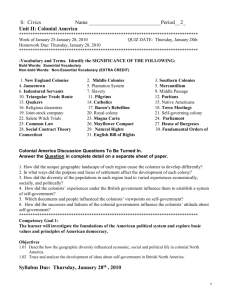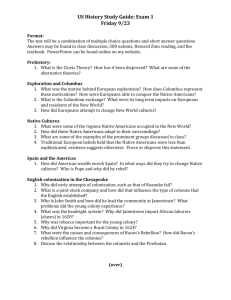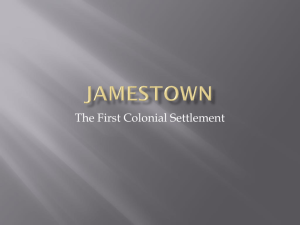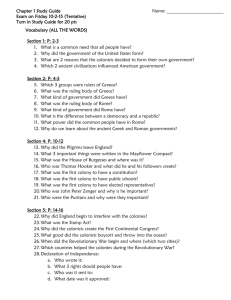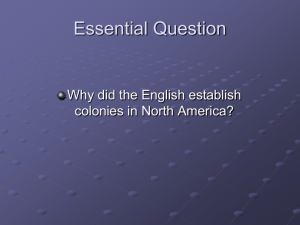Virginia House of Burgesses Mayflower Compact Fundamental
advertisement
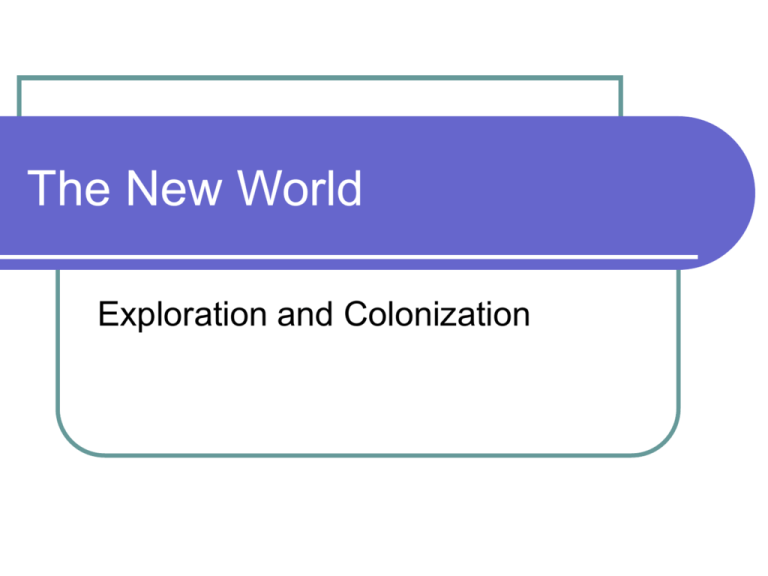
The New World Exploration and Colonization Review Portuguese Treaty of Tordesillas Spanish Armada and the ‘Sea Dogs’ Lost Colony Key Colonies (significance of Jamestown) Enlightenment/Renaissance English Protest Reformation Puritans/Separatists Mayflower Compact Virginia House of Burgesses Fundamental Orders of Connecticut Joint-Stock Companies Who really ‘discovered’ America? Did Pocahontas really save John Smith’s life? Leader of Jamestown Captured by Powhatan ‘saved’ Jamestown Natives shared food Conflict John Rolfe (Pocahontas, tobacco) Natives (agriculture, architecture, mathematics, language, sacrifice, torture) Columbus Norsemen (Leif Eriksson) Amerigo Vespucci A Tobacco Society English incentive to migrate to the New World Headright Cheap land High wages ***colonization would provide work for the unemployed, increase English trade, easy profits through raids ***negative aspects- high expectations, natives, work load, cultural/geographical differences, Spanish spies, disease, starvation, mismanagement American Colonial Rights English citizens. established colonial governments that would support self-government and the protection of individual rights. Protestantism called for independent churches which used selfgovernment. This was a contrast to what citizens of England were used to under Catholicism which relies on a centralized hierarchy. Three of these colonial governments were: Virginia House of Burgesses Mayflower Compact Fundamental Orders of Connecticut The long distance from a centralized government and existence under salutary neglect caused the colonists to become self-governing and politically self-sufficient. It would not be until the British government threatened the status of American colonists’ self-government that the colonists decided to rebel. New England Colonies close-knit, well-ordered families family was the basis of the economy with labor divided along gender lines. Settlers clustered near the town center, building churches and schools. Society was male-dominated and women mistrusted New York and New Jersey The growth of the English colonies led the Dutch West India Company to promote migration to their New Netherland colony. Competition with England caused a series of three wars that transferred New Netherland to the English. King Charles II gave the colony to his brother the Duke of York and renamed it New York. New York boasted the most heterogeneous society in North America. Rhode Island Puritans emigrated for religious freedom were not tolerant of other religious viewpoints. Thomas Hooker disagreed with church policy, founded Connecticut. Roger Williams was banished because of his views on religious tolerance and founded the colony of Rhode Island. Ann Hutchinson and her followers moved to Rhode Island. Pennsylvania King Charles II repaid a debt to William Penn's father by granting the younger Penn a huge territory west of the Delaware River. Penn was a Quaker and established his colony as a "holy experiment“ for the “Society of Friends” City of Brotherly Love Commerce and culture Direct spiritual communication with God Persecuted The Glorious Revolution 1685, King James II attempted to increase royal control by combining New York, New Jersey, and the New England colonies into the Dominion of New England. Colonial governments were disbanded and Anglican forms of worship were imposed. The Glorious Revolution of 1688 overthrew King James and colonial revolts broke out in favor of the Glorious Revolution. Parliament installed William and Mary as king and queen. The new rulers abolished the Dominion of New England and colonists revived assemblies and returned to self-government. Evolution of Chesapeake Surplus of tobacco Cost decreases in Europe Reduces planters’ profits Mortality rates decline Formation of a planter elite POLARIZATION Navigation Acts of 1650/60 (mercantilism) Carolinas Carolina was chartered but soon divided into a northern and a southern colony. North Carolina was home to 5,000 small farmers and large tobacco planters, many from Virginia. South Carolina, settlers from the sugar colony from Barbados created a plantation region with a large African slave population. Conflict intertribal and inter-colonial rivalry stimulated violence that extended from Santa Fe to Hudson's Bay. Massive violence broke out in South Carolina in the 1670s as colonists began large-scale Indian slave trade. In 1689, England and France began almost 75 years of warfare over control of the North American interior. English gains in the fur trade led to the outbreak of King William's War, (War of the League of Augsburg) in Europe. England feared loss of control of the colonies and replaced proprietary rule with royal rule. This signified the tightening of imperial reigns over the colonies of North America. Nathaniel Bacon: Bacon’s Rebellion In the 1670s, conflicts erupted between Virginia settlers and Native Americans over land Nathaniel Bacon demanded the death or removal of all Indians from the colony. The governor attempted to suppress unauthorized military expeditions. Bacon and his followers rebelled against Virginia's royal governor Stormed Jamestown When Bacon died of dysentery, his rebellion collapsed. Significance: rebellion against government authority, clash between rich/poor and east/west, greater reliance on African slave labor. King Phillip’s War Relations between the Plymouth colonists and Natives deteriorated in the 1670s. The colonists attempted to gain sovereign authority over the land of King Philip (Metacom). After peaceful coexistence lasting forty years, the Indians realized that the colonists were interested in domination. King Philip led an alliance of Indian peoples against the colonists. partly due to an alliance between the Iroquois Confederacy and the English, King Philip's War ended in defeat.
